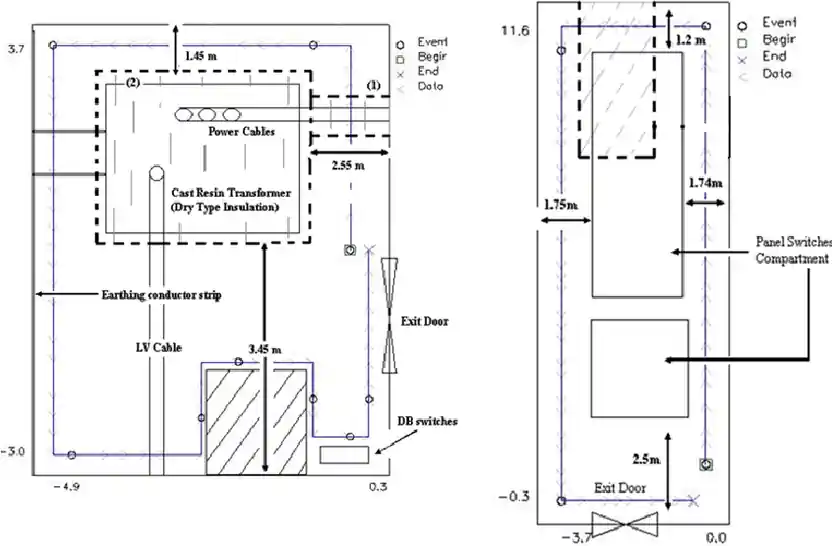In de elektrische infrastructuur worden vaak twee termen gebruikt bij het bespreken van stroomdistributie.schakelkamer en onderstation. Hoewel deze termen soms door elkaar worden gebruikt, vervullen ze verschillende rollen binnen het stroomvoorzieningsnetwerk. Inzicht in de verschillen is essentieel voor ingenieurs, facilitair managers en inkoopspecialisten die veilige, schaalbare en efficiënte energiesystemen willen ontwerpen.
Kernconcept: Schakelruimte vs. Substation
A schakelkamer is een aangewezen gebied binnen een gebouw of faciliteit waar zich schakelapparatuur voor laag- tot middenspanningdie wordt gebruikt om elektrische circuits te regelen, te beveiligen en te isoleren. Het kan gaan om stroomonderbrekers, isolatoren, bedieningspanelen en stroomrails, maar niet om bevatten meestal geen stroomtransformator.
A onderstationis aan de andere kant een uitgebreidere installatie die het volgende omvat Transformers gids, schakelmateriaal, beschermingssystemenen regelapparatuur om de spanningsniveaus tussen transmissie- en distributiesystemen te verlagen of te verhogen.

Toepassingsgebieden
Schakelkamer
- Commerciële gebouwen (hotels, winkelcentra)
- Industriële faciliteiten (fabrieken, verwerkingsbedrijven)
- Datacenters en ziekenhuizen
- Binnen geïnstalleerd, meestal in de elektrische vloer of kelder
Substation
- Energienetwerken van nutsbedrijven (transmissie en distributie)
- Integratie van hernieuwbare energie (zonne-/windmolenparken)
- Luchthavens, spoorwegen en grootschalige infrastructuurprojecten
- Kan zijn indoor, buitenof compact/prefab

Trends in de sector en evolutie van de markt
Met de opkomst van smart grids, modulaire onderstations en de integratie van hernieuwbare energie zijn het ontwerp en de functionaliteit van zowel onderstations als schakelruimtes aanzienlijk verbeterd.
Volgens IEEMA's 2023 energie-infrastructuur rapportEr is een groeiende voorkeur voor intelligent schakelmateriaal in schakelkamers uitgerust met IoT-bewaking, detectie van boogflitsenen SCADA-integratie.
Ondertussen upgraden nutsbedrijven onderstations met GIS (gasgeïsoleerd schakelmateriaal) en digitale beveiligingsrelais. Rapporten van IEEE en Schneider Electric benadrukken ook een convergentie naar hybride onderstations die traditionele apparatuur combineren met geavanceerde sensoren en communicatieprotocollen.
Technische vergelijking
| Functie | Schakelkamer | Substation |
|---|---|---|
| Spanningsbereik | Laag- tot middenspanning (LV/MV) | Middelhoog- tot hoogspanning (MV/HV) |
| Inclusief transformator? | Geen | Ja |
| Primaire functie | Controle en bescherming | Spanningstransformatie en -schakeling |
| Typische apparatuur | Installatieautomaten, stroomrails, scheiders, bedieningspanelen | Transformator, stroomonderbrekers, relais, SCADA |
| Locatie | Binnen (binnen gebouw) | Buiten/Binnen/Prefab |
| Complexiteit van constructie | Matig | Hoger |
| Naleving van normen | IEC 61439, IEC 60947 | IEC 62271, IEEE C37, IEC 60076 |
Hoe te kiezen: Schakelruimte of Substation?
De keuze hangt af van een aantal belangrijke factoren:
- Voltagevereisten
- Als je 400V of 11kV belastingen in een gebouw verwerkt, kan een schakelkamer volstaan.
- Voor step-down van 33kV of hoger is een substation essentieel.
- Beperkingen in ruimte en locatie
- Schakelkamers hebben minder ruimte nodig en zijn geïntegreerd in structuren.
- Substations hebben omheinde erven of speciale omheiningen nodig.
- Vermogen
- Substations kunnen belastingen aan van meer dan 1 MVA, terwijl schakelkamers over het algemeen lagere capaciteiten aankunnen.
- Coördinatie van regelgeving en nutsvoorzieningen
- Substations moeten vaak worden goedgekeurd door het nutsbedrijf en worden aangesloten op het elektriciteitsnet.
- Budget en implementatietijd
- Schakelkamers zijn goedkoper en sneller te bouwen.
- Onderstations omvatten civiele werken, het ontwerp van beveiligingen en de aansluiting op nutsvoorzieningen.
Toonaangevende aanbieders zoals PINEELE, ABB, Eatonen Siemens bieden beide oplossingen met aanpassingen afgestemd op IEC, ISen IEEE normen.
Gezaghebbende bronnen en referenties
- Wikipedia - Onderstation
- IEEE-std C37.100.1™: Toepassingsgids voor schakelapparatuur
- IEC 62271: Hoogspanningsschakel- en verdeelinrichtingen
- Technisch document ABB: "Ontwerpoverwegingen voor binnenruimten voor schakelapparatuur".
- Whitepaper Schneider Electric: "Digitale onderstations in stedelijke netwerken".
Deze referenties helpen ontwerpbeslissingen te valideren en zorgen voor operationele veiligheid en naleving op de lange termijn.
FAQs
A: Nee. Een schakelkamer heeft geen mogelijkheid tot spanningstransformatie. Onderstations zijn essentieel waar spanningsstappen nodig zijn (bijv. 33kV naar 11kV of 11kV naar 415V).
A: Ja. Veel grote projecten hebben een gids voor elektrische onderstations voor transformatie en een schakelkamer voor interne distributie en regeling.
A: Niet noodzakelijkerwijs. Beide kunnen even veilig zijn als ze goed zijn ontworpen. Schakelkamers bevinden zich meestal binnen en zijn gemakkelijker toegankelijk, maar onderstations hebben vaak geavanceerdere beveiligingssystemen.
Inzicht in de verschil tussen een schakelruimte en een onderstation is essentieel voor het ontwerpen van effectieve elektrische distributiesystemen. Terwijl een schakelruimte compacte controle biedt binnen gebouwen, is een onderstation onmisbaar voor spanningsoplossingen transformatie en grootschalige distributie.


